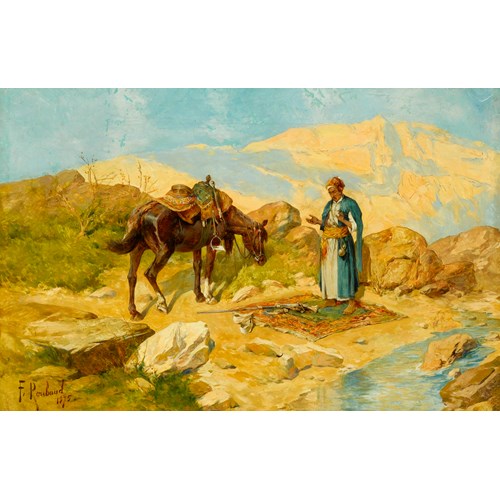Marketplace
The Crucifixion
Martin Schongauer
The Crucifixion
Date 1475
Epoque 1400-1600, 15th century
Origine France, Germany
Medium Tempera on wood
Dimension 105 x 75.8 cm (41³/₈ x 29⁷/₈ inches)
The Crucifixion is painted after an engraving by Martin Schongauer, c.1475, one of his largest and most detailed depictions of the subject by one of his followers, and is thought to have been executed c.1500. The painted version, although slightly different from the engraving, reflects the balance and harmony of Schongauer’s composition. In the painting, there is most noticeably the addition of the figure of a donor, and parts of the landscape have been simplified. Christ’s crown of thorns has been replaced by a halo. Although The Crucifixion by necessity loses some of the complexity of the original etching, the addition of colour and painterly technique heightens the dramatic power of the image.
In both works, at the centre of the composition is Christ on the cross. At his head is the inscription I.N.R.I., from the Latin Isvs Nazarenvs Rex Ivdœorvm, meaning ‘Jesus the Nazorean, King of the Jews’ (John 19:19). Flanking him is the Virgin Mary on the left and St. John the Evangelist on the right. In The Crucifixion, the donor kneels in a supplicant pose next to the Virgin, with words rising above him on a scroll and a crest with three mallets at his feet. Perhaps the most captivating element of the work is the depiction of four angels hovering around the cross, each holding a golden chalice to catch the drops of Christ’s blood. The voluminous flowing robes and drapery of the angels and saints, and the loincloth worn by Christ, are masterfully conveyed in Schongauer’s engraving, as well as in the present painting with a combination of expressive line, shadowing and highlights.
Although Schongauer is best known as an engraver, and his works were widely disseminated and copied throughout Europe, in his time he was also famous as a painter.¹ His practise as an engraver gave his paintings greater refinement in draughtsmanship and visual depth. There are only a small number of paintings that can be attributed with certainty to Schongauer, while the majority once considered to be by him are now thought to be products of his workshop. One such work is Noli me Tangere in the Musée d’Unterlinden in Colmar, France. Interestingly, the painting bears a number of stylistic similarities to the present picture, particularly in the way that Christ’s emaciated figure and pronounced facial structure are depicted. Whether the painter of The Crucifixion may have come into contact with Schongauer’s workshop, or the master himself, is unknown; however, the artistic parallels between the two works are striking.
We are grateful to Ludwig Meyer of the Munich History of Art Archive for proposing that the painter of The Crucifixion had knowledge of Schongauer’s engraving.
¹ John M Jeep, Medieval Germany: An Encylopedia, Routledge, 2001, p 631.
In both works, at the centre of the composition is Christ on the cross. At his head is the inscription I.N.R.I., from the Latin Isvs Nazarenvs Rex Ivdœorvm, meaning ‘Jesus the Nazorean, King of the Jews’ (John 19:19). Flanking him is the Virgin Mary on the left and St. John the Evangelist on the right. In The Crucifixion, the donor kneels in a supplicant pose next to the Virgin, with words rising above him on a scroll and a crest with three mallets at his feet. Perhaps the most captivating element of the work is the depiction of four angels hovering around the cross, each holding a golden chalice to catch the drops of Christ’s blood. The voluminous flowing robes and drapery of the angels and saints, and the loincloth worn by Christ, are masterfully conveyed in Schongauer’s engraving, as well as in the present painting with a combination of expressive line, shadowing and highlights.
Although Schongauer is best known as an engraver, and his works were widely disseminated and copied throughout Europe, in his time he was also famous as a painter.¹ His practise as an engraver gave his paintings greater refinement in draughtsmanship and visual depth. There are only a small number of paintings that can be attributed with certainty to Schongauer, while the majority once considered to be by him are now thought to be products of his workshop. One such work is Noli me Tangere in the Musée d’Unterlinden in Colmar, France. Interestingly, the painting bears a number of stylistic similarities to the present picture, particularly in the way that Christ’s emaciated figure and pronounced facial structure are depicted. Whether the painter of The Crucifixion may have come into contact with Schongauer’s workshop, or the master himself, is unknown; however, the artistic parallels between the two works are striking.
We are grateful to Ludwig Meyer of the Munich History of Art Archive for proposing that the painter of The Crucifixion had knowledge of Schongauer’s engraving.
¹ John M Jeep, Medieval Germany: An Encylopedia, Routledge, 2001, p 631.
Date: 1475
Epoque: 1400-1600, 15th century
Origine: France, Germany
Medium: Tempera on wood
Dimension: 105 x 75.8 cm (41³/₈ x 29⁷/₈ inches)
Plus d'œuvres d'art de la Galerie









